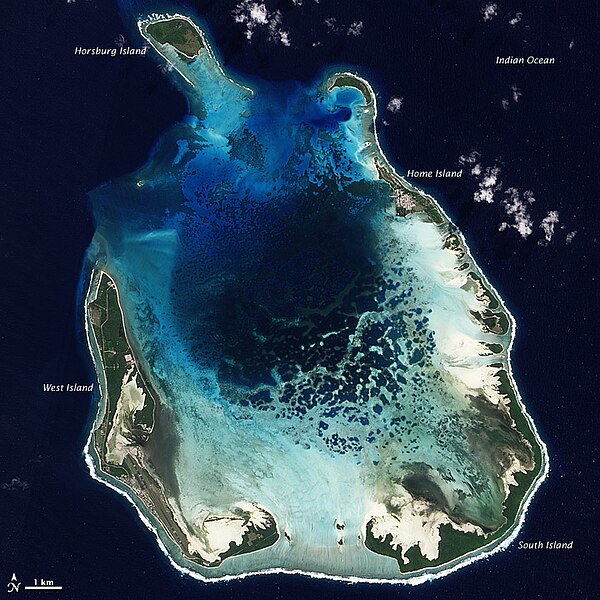File:Cocos (Keeling) Islands - NASA Earth Observatory.jpg

Original file (720 × 720 pixels, file size: 197 KB, MIME type: image/jpeg)
Captions
Captions
Summary[edit]
| DescriptionCocos (Keeling) Islands - NASA Earth Observatory.jpg |
To download the full resolution and other files go to: earthobservatory.nasa.gov/IOTD/view.php?id=76791&src=... The Cocos (Keeling) Islands lie in the eastern Indian Ocean, about 2,900 kilometers (1,800 miles) northwest of the Australian city of Perth. Comprised of coral atolls and islands, the archipelago includes North Keeling Island and the South Keeling Islands. The Advanced Land Imager (ALI) on NASA’s Earth Observing-1 (EO-1) satellite captured this natural-color image of South Keeling Islands on July 31, 2009. Coral atolls—which are largely composed of huge colonies of tiny animals such as cnidaria—form around islands. After the islands sink, the coral remains, generally forming complete or partial rings. Only some parts of South Keeling Islands still stand above the water surface. In the north, the ocean overtops the coral. Along the southern rim of this coral atoll, the shallow water appears aquamarine. Water darkens to navy blue as it deepens toward the central lagoon. Above the water line, coconut palms and other plants form a thick carpet of vegetation. In 2005, the Australian government issued a report on the Cocos (Keeling) Islands, summarizing field research conducted between 1997 and 2005. Hard corals, which play a primary role in reef building, were not the only corals at South Keeling Islands. Soft coralswere also thriving at study sites throughout the reef. Although coral and rock predominated, the researchers also found varying amounts of silt, sand, rubble, sponges, and seaweed. Some of the coral had recently died, and coral predators appeared in high densities at some sites> But overall, the report noted, “the coral reef community at Cocos (Keeling) Islands is very healthy and in a stable period, with little impact from anthropogenic activities.” NASA Earth Observatory image created by Jesse Allen and Robert Simmon, using EO-1 ALI data provided courtesy of the NASA EO-1 team. Caption by Michon Scott. The Earth Observatory's mission is to share with the public the images, stories, and discoveries about climate and the environment that emerge from NASA research, including its satellite missions, in-the-field research, and climate models. Like us on Facebook Follow us on Twitter Add us to your circles on Google+ |
| Date | |
| Source | Cocos (Keeling) Islands |
| Author | NASA's Earth Observatory |
| Camera location | 12° 09′ 58.36″ S, 96° 52′ 38.79″ E | View this and other nearby images on: OpenStreetMap |
|---|
Licensing[edit]
- You are free:
- to share – to copy, distribute and transmit the work
- to remix – to adapt the work
- Under the following conditions:
- attribution – You must give appropriate credit, provide a link to the license, and indicate if changes were made. You may do so in any reasonable manner, but not in any way that suggests the licensor endorses you or your use.
| This image was originally posted to Flickr by NASA Earth Observatory at https://www.flickr.com/photos/68824346@N02/6581998059. It was reviewed on 2 July 2012 by FlickreviewR and was confirmed to be licensed under the terms of the cc-by-2.0. |
2 July 2012
File history
Click on a date/time to view the file as it appeared at that time.
| Date/Time | Thumbnail | Dimensions | User | Comment | |
|---|---|---|---|---|---|
| current | 17:15, 2 July 2012 |  | 720 × 720 (197 KB) | Dzlinker (talk | contribs) | == {{int:filedesc}} == {{Information |Description=To download the full resolution and other files go to: [http://earthobservatory.nasa.gov/IOTD/view.php?id=76791&src=flickr earthobservatory.nasa.gov/IOTD/view.php?id=76791&src=...] The Cocos (Keeling) ... |
You cannot overwrite this file.
File usage on Commons
The following page uses this file:
- File:Cocos (Keeling) Islands (6581998059).jpg (file redirect)
File usage on other wikis
The following other wikis use this file:
- Usage on af.wikipedia.org
- Usage on ceb.wikipedia.org
- Usage on de.wikipedia.org
- Usage on de.wikivoyage.org
- Usage on es.wikipedia.org
- Usage on fy.wikipedia.org
- Usage on he.wikipedia.org
- Usage on ko.wikipedia.org
- Usage on vi.wikipedia.org
- Usage on www.wikidata.org